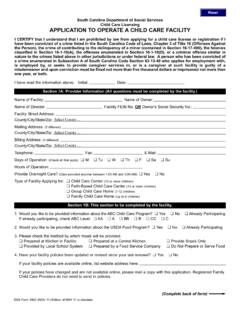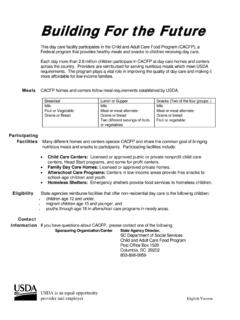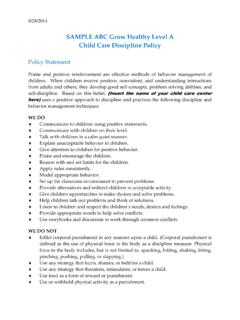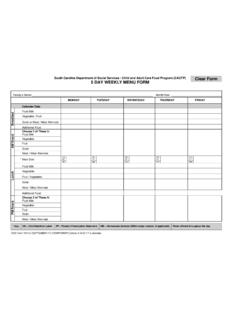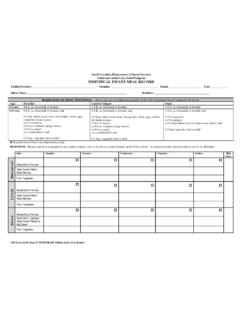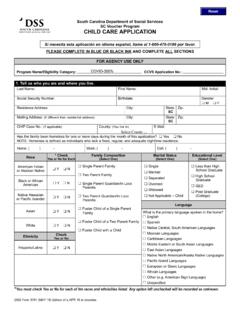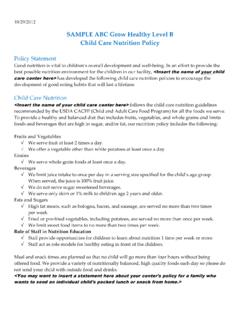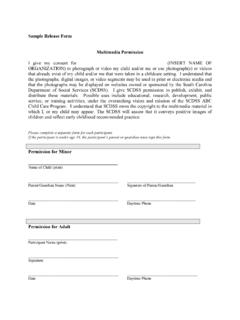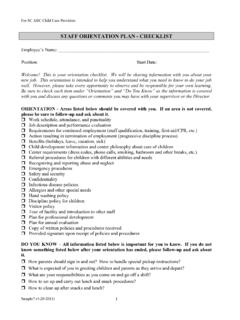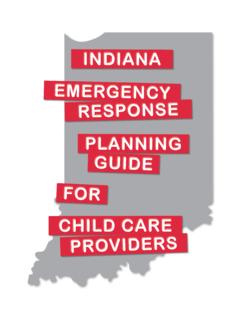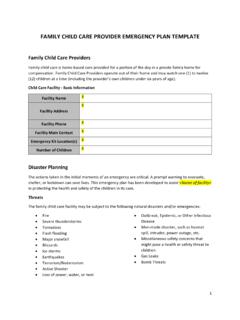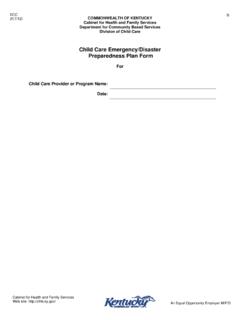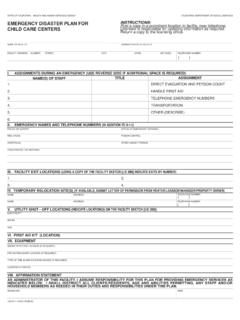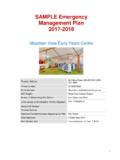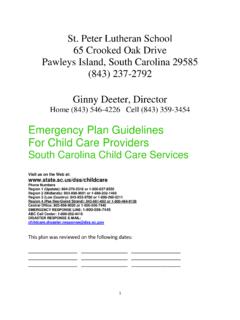Transcription of Division of Early Care and Education Child Care …
1 Revised April, 2013 South Carolina Department of Social Services regulations require Child care facilities to have a plan in place that addresses emergency medical situations and evacuation in the event of an emergency or disaster. The Division of Early care and Education has developed these guidelines to assist Child care facilities develop their own plan . Visit us on the Web at: Phone Numbers Region 1 (Upstate): 864-250-5576 or 1-800-637-8550 Region 2 (Midlands): 803-898-9001 or 1-888-202-1469 Region 3 (Low Country): 843-953-9780 or 1-800-260-0211 Region 4 (Pee Dee/Grand Strand): 843-661-6623 or 1-800-464-9138 Central Office: 803-898-9020 or 1-800-556-7445 emergency LINE: 1-888-825-7174 DISASTER RESPONSE E-MAIL: Division of Early care and Education Child care emergency plan Guidelines Revised April, 2013 Page 2 plan Practice Communicate Regulations of the South Carolina Department of Social Services require that Child care facilities have a plan in place that addresses emergency medical situations and evacuation in the event of an emergency or disaster.
2 The Division of Early care and Education has developed the following guidelines to assist Child care facilities in developing their own plan . I. Develop a list of emergency phone numbers. The first item to have in place for a medical emergency or an emergency evacuation is a list of emergency phone numbers. The following chart lists examples of people you might have on your chart. This chart can be used as it is. Just fill in the information that applies to your facility and list additional names and numbers that you need in the blank spaces at the bottom of the chart. emergency Phone Numbers Title/Agency Contact Name Phone Number Facility Director emergency N/A 911 Police (non- emergency ) Fire (non- emergency ) Poison Control Local Health Dept. Building Inspector Dept. of Social Services DSS Regulatory Specialist Alternate/Evacuation Site Revised April, 2013 Page 3 plan Practice Communicate II.
3 Medical Emergencies A. DSS regulation 114-505 C(1)(a) states that your plan must include medical conditions under which emergency care and treatment is warranted. Below is a list of medical emergencies that would require immediate medical care by a health care professional. This list only serves as a model of conditions that might be included in your plan . Loss of consciousness Semi consciousness Breathing difficulties Severe bleeding Unequal pupils Seizure Neck or back injury Continuous clear drainage from nose/ears after a blow to the head Severe headache Stiff neck or neck pain when head is moved Hives that appear quickly Very sick Child who seems to getting worse quickly Repeated forceful vomiting Vomiting blood Severe abdominal pain that causes a Child to double over Abdominal pain after a blow to the abdomen Possible broken bones Shock B.
4 DSS Regulation Number 114-505 C(1)(b) states that your emergency plan must include steps to be followed in a medical emergency . The following information is a sample of what your plan could contain. Train staff to recognize signs and symptoms of conditions that require immediate medical attention. Call 911 immediately upon recognizing signs and symptoms that require immediate medical attention. Call the Child s parent/guardian immediately after calling 911 to inform them of the Child s symptoms and where they will be transported for medical care . Provide first aid as trained in an approved First Aid training course until emergency personnel arrive. Take the Child s emergency medical information form(s) with you to the hospital and remain with the Child until a parent arrives. Include the hospital or source of health care to be used in your plan .
5 Include the method of transportation to be used in case of an emergency . Revised April, 2013 Page 4 plan Practice Communicate III. emergency Evacuation Procedures DSS regulation 114-505 H(3) states, The facility shall have an up to date written plan for evacuating in case of fire, a natural disaster, or other threatening situation that may pose a health or safety hazard. The facility shall also include procedures for staff training in this emergency plan . A. Preparedness 1. Child care facilities are required to have policies and procedures to evacuate the facility quickly in case of an emergency . The plan should be developed to consider the following evacuation scenarios: a. In-place evacuation: Keeping children and staff members in place but securing location for the emergency at hand. Example: tornado or chemical release b.
6 On site evacuation: Movement of children and staff members out of buildings affected and relocated to other areas on premise or property. c. Off site evacuation: Movement of some or all children and staff members off campus to another designated area. d. Major Disasters or Emergencies e. Radiological Evacuations (to be completed by providers located within a 10 mile radius of a nuclear power plant in the following counties: Aiken, Allendale, Barnwell, Chesterfield, Darlington, Fairfield, Lee, Lexington, Newberry, Oconee, Pickens, Richland, and York) Sample plans are provided in the accompanying template to serve as a model of how providers could construct their own evacuation plans. Providers may use the wording of these plans as is and fill in the blanks with information that applies to their facility. Before listing alternate/evacuation sites in your plan , it is recommended that you have written permission to use those sites.
7 2. Review the plan annually and update it as needed. Document the date of the reviews on the front cover of your plan . If you use the template provided by the Division of Early care and Education , space is provided on the front cover for this documentation. 3. Have the plan available for immediate review by staff, parents, and Child care Licensing during business hours. 4. Train each Child , of capable age, on the emergency evacuation procedures during orientation. Conduct fire drills monthly and other disasters at least every 6 months. Facilities that offer night care must conduct fire drills during sleeping hours at least every 60 days. See DSS Regulation 114-509 C(2). Document the time, date, and type of drill in your plan . Space is provided for this documentation in the template. 5. When children are relocated, staff will maintain the children s records as well as documentation for a Child s release to an authorized person.
8 6. Develop arrangements for mutual aid/relocation with other facilities and schools in your area. Revised April, 2013 Page 5 plan Practice Communicate 7. Know where to locate emergency information stations on television and radio, have a staff member monitor these stations during an impending emergency situation, and pay attention to warnings. 8. Develop a plan for the safe and prompt evacuation of infants, toddlers, and non-ambulatory children. 9. Develop a plan for the release of children which include safeguards to prevent the inappropriate release of a Child to an unauthorized person. 10. Include a means to post the relocation site address in a conspicuous location that can be seen even if the center is closed. 11. Make sure emergency supplies are available including but not limited to items listed below. 12.
9 Make sure that vehicles have at least tank of gas. 13. Assign staff members specific responsibilities such as those listed below during an emergency . Make sure the assignments include who will supervise which children. Reminder: DSS Regulation 114-505 C(3) requires a staff member to remain at the hospital or emergency location until a parent arrives. Contact List for Children s Families Hand Sanitizer/Cleaning Agent/Disinfectant Contact List for Staff Families Wet Wipes and Tissues Children s emergency Information Disposable Cups Medications/Medical Supplies Water and Non-Perishable Food Charged Cell Phone Diapers for Infants First Aid Kit Formula for Infants Flashlights w/extra batteries Blankets Battery operated radio w/extra batteries Vehicle Keys Assigned Task Staff Member Call 911 Call Parents/Guardian Provide First Aid (must be certified) Take Children s emergency Medical Files Take emergency /First Aid Kits Go with children to hospital Turn off gas, electricity, and water Post relocation site information Supervision of Children Revised April, 2013 Page 6 plan Practice Communicate 14.
10 Include the hospital or source of health care to be used in your plan . 15. Include the method of transportation to be used in case of an emergency or off site evacuation. 16. Train and drill staff members on their responsibilities during an emergency . Staff orientation shall include training on the emergency plan . Practice the evacuation plan on a regular basis to ensure that it works, to help all staff know what to do, and to avoid panic. Involve the children in the drill in a way that will not frighten them. For example, tell them that you are practicing ways to keep them and you safe in case of an emergency instead of calling the exercise a fire drill, evacuation drill, etc. Use drills to help you evaluate, modify, and update your plan to make it more effective and efficient. 17. Child care facilities are required by the Fire Marshal to have an Escape plan and a Fire plan .
